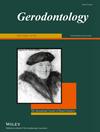Association between frailty and oral health services use in Brazilian older adults
Abstract
Objectives
To assess the association between frailty and oral health services use in Brazilian older adults.
Methods
This cross-sectional study analysed the baseline data from the Longitudinal Study on Brazilian Ageing (ELSI-Brazil) representative of Brazilians aged 50 or over. The outcome was oral health services used in the year prior to the interview. The main exposure variable was Frailty defined by the frailty phenotype. Age, skin colour, wealth, sex, education, type of service, health insurance, number of teeth and self-perceived oral health were included as covariates. Prevalence ratios (PR) with their respective 95% confidence intervals (CI) were estimated using Poisson regression with robust variance.
Results
8405 individuals were included in this study. The prevalence of frailty was 7.5%. Regarding frailty status, the prevalence of dental service use was 47.0%, 48.5% and 4.5% for robust, pre-frail and frail individuals, respectively. Frail individuals had a 7% higher prevalence of not using dental (PR: 1.07; 95% CI: 1.01–1.13) than robust individuals. Frailty was independently associated with not using oral health services.
Conclusion
Given the complexity of the determinants of dental service use, frailty adds another dimension to be examined in older adults. Public health strategies considering a common risk factor approach should be endorsed.

 求助内容:
求助内容: 应助结果提醒方式:
应助结果提醒方式:


